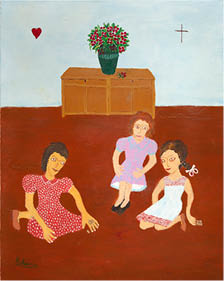A reflection on the Bienal Naïfs do Brasil
Edna Matosinho de Pontes
Collector, researcher and gallerist
The terminology used to define the type of art featured in this exhibition is wide-ranging and has been the subject of many other texts written for previous editions of the biennial. The various terms often used to denote this art include “naive”, “innate”, “primitive”, and “popular”.
The term “naive” refers to ingenuousness. The recurring discussion tends to revolve around the appropriateness of naming this very important biennial in this way, according to its particularity of focusing on those artists who reject or lack formal training in art, opening a space for them to show their work.
The question of “naive/ingenuous” was aptly considered by Olívio Tavares de Araújo, when he was curator of the special room of the Bienal Naïfs do Brasil in 2008; he said: “In practice, especially by influence from Eastern Europe, where this type of art abounds, the label “naive” is usually applied to less incisive artists… They know various artistic techniques, they know how to draw reasonably well, and how to mix paints to create pleasant degradés in their landscapes…”. It is precisely taking into account this definition and this framing of “naive” within a specific technical perspective that this name should be questioned.
There is no proper consensus concerning a better terminology. The term “primitive” tends to carry a built-in negative judgment value that depreciates it. The term “innate”, which is equivalent to spontaneous, can be seen as suitable in many aspects, but it is little known or used. The current tendency is to use the name “popular art” to characterize the art produced by artists who lack or reject formal art training. This does not mean that it is the best definition, but it does specify more precisely the sort of art we are referring to and for this reason it has been adopted as the one conventionally used.
The conception of popular art as a living expression of the inventiveness of the soul of our people, who reinvent reality in their own way through their fantasy, guided our work as members of the 2012 Biennial’s jury.
I was enormously satisfied to work with this group which is heterogeneous in terms of their professional experience, but which worked as a true team. The selection of the artworks was made in a very careful, reflexive and democratic way. Some criteria for the choice of the artworks to be shown were consensual. We considered the artist’s experience and background. We sought to avoid works by artists who had the influence of a specific art training or whose work portrays situations apart from their own condition of life. For this reason we also analyzed their biographies. SESC’s initiative to valorize and show this sort of production at each biennial held over the years is really praiseworthy. There are few opportunities for the popular artist to receive so much attention and space to show his/her work. Because such works are normally excluded from the art exhibition circuit, they tend to be undervalued.
This edition of the biennial features 536 works (each artist participating with two), representing twenty states of Brazil. We had a range of themes that are very frequent in popular art: rural landscapes and cityscapes, popular (folkloric and religious) festivals, scenes from everyday life, representations of current issues. Beyond the mastery of their production, we sought to take into consideration the sensitivity and sincerity of their approach, their originality, and the use of infrequent techniques and materials.
Most of the works entered consisted of paintings made with oil or acrylic paints. Woodcuts and three-dimensional works in ceramic or stone were rare, and there were few wooden sculptures — though they are very representative of the world of popular art.
The representation of the memory of a bygone time is part of the experience of older people, who lived during that time. In this direction, for example, we have beauty, sensibility and sincerity in the work by Maria Caldeira Bochini, an 82-year-old artist. In her we perceive the nostalgic soberness, the economy of colors and the absence of superfluous details. It is not, in any way, a mellifluous and unnecessarily embellished portrait.
An exception in terms of three-dimensional works was a surprising iron head made by Evandro Soares. It demonstrates originality, skill, cleverness and includes movement by way of a simple mechanism that makes a helix turn. It is a work that evidences effort and perseverance in its elaborate realization.
Unlike at the other editions, where there was a separate space for the special room conceived by the curator, this edition’s curator Kiki Mazzuccheli decided to show contemporary artworks in the same space, alongside the popular art. This reflects and reinforces the valorization of the production of the popular artists, a hallmark of the Piracicaba Biennial.
In 2009, Galeria Pontes, which I direct, held the exhibition Mecânica Inexata [Inexact Mechanics], focused on the dialogue between popular art and contemporary art, curated by Jacopo Crivelli Visconti. That exhibition showed that this dialogue is possible and has a fluidity that naturally flourishes. In the text written for the show, Crivelli Visconti says that this dialogue allows us to talk “about the need to recompose the recent and unnecessary fracture that divides artistic practice into two separate worlds, which should return to being side-by-side and thus understood in another way. About the conviction that the proximity of distinct artworks and thoughts is healthy and desirable, as it molds and defines the spirit of a nation, of a culture… In short, about the desire of a more frequent shared experience, of a fertile and continuous exchange of ideas…” These are propositions that I totally agree with.
Despite the high representativity of the Brazilian states in this 11th Bienal Naïfs do Brasil, I will make a brief comment here — thinking about future biennials — concerning how enriching it would be in terms of the diversity of techniques and the use of materials to enlarge the scope geographically with the inclusion of a number of works from states with a wealth of popular art production, especially those in the Northeast.

